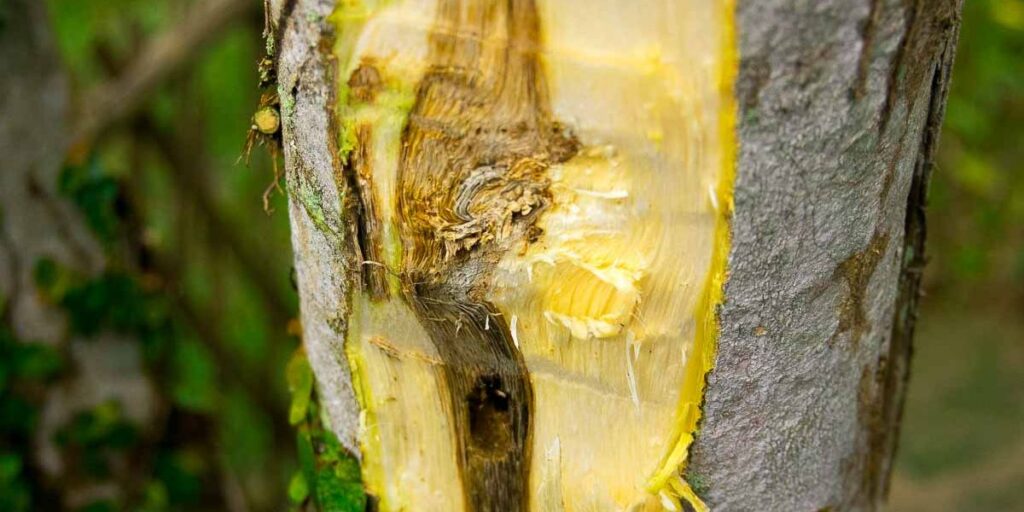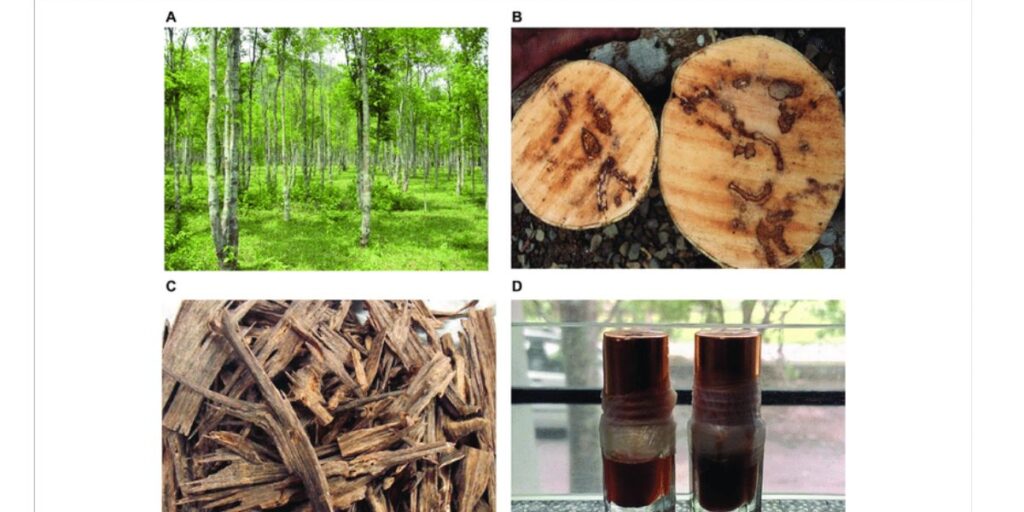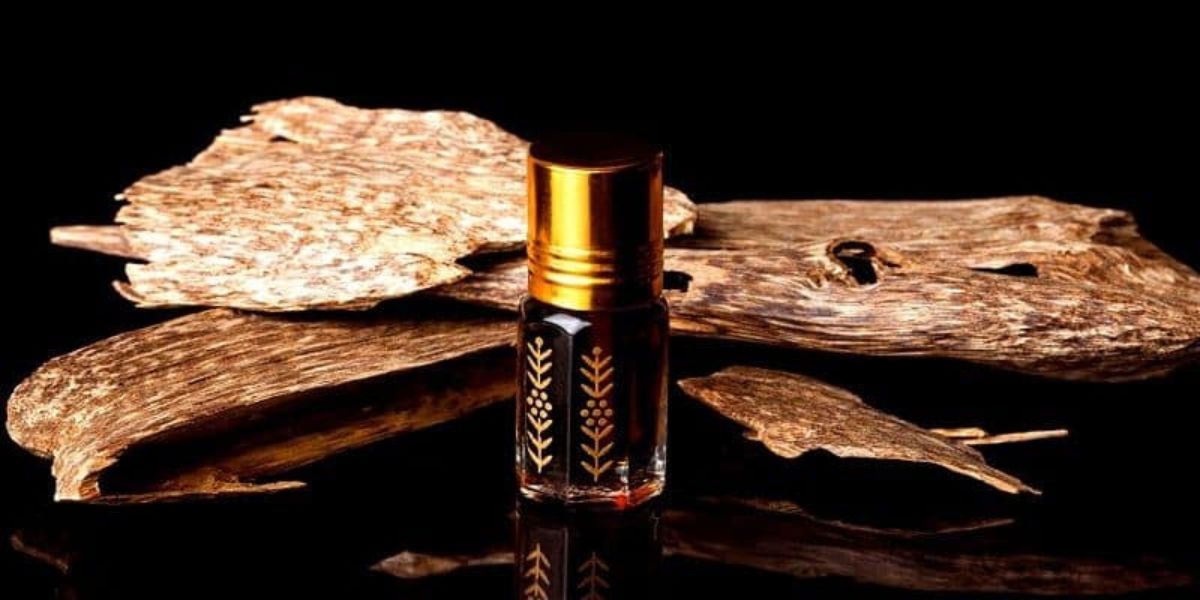Oud is a fragrance with an enigmatic, enthralling, and intensely aromatic character.
Loved by perfume enthusiasts, this regal scent is known as one of the most opulent ingredients in perfumery for its profound and complex aroma.
But what is the secret that makes agarwood such a valuable raw material in perfumery?
It begins with the Aquilaria tree, a unique type of tree that is native to Southeast Asia.
This tree, when it goes through a spontaneous process—caused by a fungal infection—creates a dark, resinous heartwood named agarwood.
This is the substance that is so much valuable and desirable.
Oud has a warm, woody scent that is intense and captivating. It can be sweet, smoky, or musky, and it changes incredibly on the skin.
The soaring demand and the intricate extraction process have gained agarwood the popular name of “liquid gold.”
Join us as we explore the origin of this loved raw material used in perfumery, its distinctive smell, and the reasons behind its high value in the fragrance industry.
Origin and Production: what is oud made from?
The substance both known as oud and agarwood comes from the central timber of the Aquilaria tree.
South Asian tropical regions serve as the natural habitat for this unique plant which gains its cultural value through its strong scent.
The formation of oud through the Aquilaria tree is a testament to the amazing cycle of life:
- First, the tree is infected by a specific type of fungi known as Phialophora parasitica;
- Once the infection is established, as a defence mechanism the tree produces a dark, resin-like substance in its heartwood;
- This defensive mechanism ultimately produces what is known as agarwood

But this peculiar and fascinating natural phenomenon is not the only factor that makes oud such a precious raw material.
The extraction of the agarwood is not an easy task to perform; it needs skill and great patience from everyone involved.
Master craftsmen locate the wood areas with resin before extraction to get high-quality material for their work.
Distillation of extracted wood leads to the production of oud oil after a prolonged distillation cycle.
The completed oud product shows its authentic scents alongside reflecting the battle and persistence of this tree and revealing the dedication behind its creation.
The outcome regarding product quality can differ because of multiple elements including purity together with age alongside the distinct Aquilaria species selected for its creation.
The aromatic profile: what does oud smell like?
The oud fragrance presents itself as a rich and complex scent which creates an exceptional sensory perception.
The base of this scent features deep wood scents which reveal sweet notes and stronger smoky aromas.
The sophisticated nature of this raw material creates an enchanting effect which enables people to uncover fresh discoveries every time they experience it.
Its fragrance produces an olfactory journey with dual characteristics that balance rich depth with a warm musky undernote.
However, different oud varieties produce distinctive aromatic characteristics which must be acknowledged.
The scent profile of oud depends heavily on the particular geographic origin of Aquilaria trees together with the age of extracted resin.
Geographic influence:
- Cambodia: The fragrant wood from Cambodia contains a distinctive combination of sweet fruity scents together with earthy base notes. The profile attracts high demand in the perfumery industry.
- Thailand: The scents of Thai oud resemble Cambodian oud yet it tends to have a milder fruity quality. Its aroma contains a sugary essence accompanied by subsoil and mineral elements.
- Vietnam: Vietnamese oud produces fragrances which are sweet yet bitter and spicy at the same time. Binh Thuan Province in Vietnam possesses “Kinam” which stands as a unique agarwood variety with fresh sweet scents.
- Malaysia: The oud of Peninsular Malaysia exhibits fragrance characteristics identical to Thai and Cambodian oud through its combination of earthy scents alongside sweet notes. Oud originating from eastern Malaysia (Borneo) showcases herbal scents that combine dryness, mossy and earthy notes.
- Laos: this oud has a strong woody aroma which becomes sweet and pungent as time passes.
Impact of the resin age on the scent profile
- Young resin: the aroma of a young resin tends to be soft and light due to its fresh and delicate scent profile
- Old resin: the aging process transforms resin into a scent with richer complex aromas which are typically deeper resinous with enhanced warm attributes and deep notes
In summary, the distinctive and intricate scent of agarwood results from both the geographic origin of the Aquilaria trees and the length of time the resin matures. Multiple environmental aspects unite to create various aromatic scents that perfumers value throughout the industry.
Why is oud so expensive?
The oud harvesting process demands extensive labour and prolonged patience because it is a complex and time-consuming operation.
Also, it must be mentioned that not every single Aquilaria tree will yield oud resin.
The unreliable production further reduces available supplies thus making the substance even more desirable in commercial markets.
Another element that makes agarwood so expensive is its production.
The production process requires precise multiple steps to achieve both purity and quality standards:
- Harvesting: Natural tree infections together with exterior damage trigger Aquilaria trees to produce dark aromatic resin which eventually develops into Agarwood. The tree production of sufficient resin causes the harvesting of affected wood sections. Special care is taken to remove the resin-impregnated wood from the rest of the wood material.
- Preparation of the chips: The resinous wood needs to be cut into small chips because this action creates more area for extraction to occur. The chips receive sun-drying treatment for multiple days because this step decreases their water content and benefits the following extraction procedures.
- Soaking and fermentation: During fermentation, the dried agarwood chips are placed in water they require soaking time between several days and weeks. During fermentation, the wood structure undergoes breakdown which simplifies oil extraction during distillation.
- Distillation: The extract process of essential oil starts after the agarwood chips complete their fermentation phase. There are two primary methods:
- The fermented wood pieces receive total submersion in water while boiling at high temperatures. The process of condensation produces an oil-water mixture by collecting steam from the aromatic compounds. Due to its density properties, the oil remains atop the liquid separation.
- Through steam distillation, the essential oils from agarwood chips will vaporize when steam flows through the material. After condensation of the vapour back into liquid form, the oil separates itself from water. The procedure maintains high efficiency when extracting fragile aromatic compounds from raw materials.
- Collection and purification: The extracted oil undergoes filtration to eliminate impurities before the final collection of the product. The commercial value of oil depends completely on its level of purity and quality.

The production of agarwood oil follows a time-consuming process which uses large amounts of raw materials.
The extraction process requires between 8,000 and 10,000 kilograms of raw material to create one litre of oil.
The name “liquid gold” accurately represents oud because both its worth and its scarcity level align.
The increasing oud market demand coupled with scarce raw material supply results in higher market prices. The premium associations connected to oud work to both sustain and boost its market value which keeps it as an emblem of wealth.
How to choose the best oud fragrance?
The selection of an appropriate oud fragrance demands personal involvement in the process.
You can find oud scents that match your personality because they exist in different scent categories between soft floral fragrances and dark resinous ones.
Those looking for a fragrance which unites powerful elegance can find their ideal choice in Rozzo Extrait de Parfum.

The perfume begins with a fragrant rose-peach union before it unveils the profound oud and smoky woody essence.
The dual nature of Rozzo allows it to be effective during both day and night hours because its initial fresh tones are suitable for active daylight activities but the luxurious oud notes extend beautifully throughout evenings.
Rozzo’s scent evolution throughout the day creates personalized notes of velvety rose and radiant peach with rich oud that never present themselves in the same way twice.
Conclusion
Oud represents more than just a fragrance, it is a symbol of rarity, craftsmanship and timeless allure.
People who adopt oud as their scent discover an artistic realm where they can experience its woodsy base and smoke-infused depth and light floral notes.
The natural creation of oud has led to its human-altered version which continues to enchant global communities due to its status as an enduring symbol of luxury and distinction.




